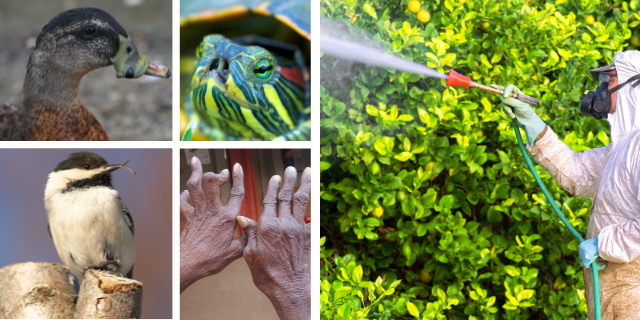The smart Trick of Eco Bed Bug Exterminators Dc That Nobody is Talking About
The smart Trick of Eco Bed Bug Exterminators Dc That Nobody is Talking About
Blog Article
The 10-Second Trick For Eco Bed Bug Exterminators Dc
Table of ContentsEco Bed Bug Exterminators Dc - QuestionsAn Unbiased View of Eco Bed Bug Exterminators DcThe Main Principles Of Eco Bed Bug Exterminators Dc Eco Bed Bug Exterminators Dc Fundamentals ExplainedSome Known Factual Statements About Eco Bed Bug Exterminators Dc
Because pesticides are harmful, they are likewise possibly dangerous to people, pets, various other organisms, and the environment. People who use chemicals or regularly come in call with them must recognize the family member toxicity, possible wellness impacts, and preventative steps to reduce exposure to the items they use. Threat, or danger, of using chemicals is the capacity for injury, or the level of danger entailed in making use of a pesticide under a provided set of conditions.
Nevertheless, applicators can reduce or virtually get rid of exposure-- and therefore decrease threat-- by complying with the tag guidelines, using individual protective clothes and devices (PPE), and handling the chemical correctly. For instance, more than 95 percent of all pesticide direct exposures come from dermal exposure, largely to the hands and forearms. By putting on a set of unlined, chemical-resistant gloves, this type of exposure can be nearly removed.
The hazardous impacts that take place from a solitary exposure by any type of path of access are described "intense impacts." The four routes of exposure are dermal (skin), inhalation (lungs), oral (mouth), and the eyes. Severe poisoning is identified by analyzing the facial toxicity, breathing poisoning, and dental toxicity of examination animals.
The Best Guide To Eco Bed Bug Exterminators Dc
Severe toxicity is determined as the amount or concentration of a toxicant-- the a.i.-- required to eliminate 50 percent of the pets in an examination population. This measure is typically revealed as the LD50 (lethal dose 50) or the LC50 (dangerous focus 50). Additionally, the LD50 and LC50 worths are based on a solitary dose and are recorded in milligrams of pesticide per kg of body weight (mg/kg) of the examination animal or partly per million (ppm).
The reduced the LD50 or LC50 value of a pesticide product, the greater its toxicity to humans and pets. Pesticides with a high LD50 are the least harmful to humans if utilized according to the instructions on the product tag. The chronic poisoning of a chemical is identified by subjecting examination pets to long-term direct exposure to the active ingredient.
The persistent toxicity of a chemical is harder than severe toxicity to identify through research laboratory analysis. Products are classified on the basis of their loved one acute poisoning (their LD50 or LC50 worths). Chemicals that are identified as very toxic (Poisoning Group I) on the basis of either oral, dermal, or inhalation poisoning should have the signal words threat and poisonous substance published in red with a skull and crossbones icon plainly presented on the front panel of the bundle label.
The severe (solitary dosage) oral LD50 for pesticide items in this team ranges from a trace amount to 50 mg/kg. For instance, direct exposure of a couple of decreases of a material taken orally can be deadly to a 150-pound individual. Some chemical items have just the signal word threat, which tells you absolutely nothing regarding the acute poisoning, just that the product can create severe eye damages or serious skin irritation
How Eco Bed Bug Exterminators Dc can Save You Time, Stress, and Money.
In this group, the acute oral LD50 other varieties from 50 to 500 mg/kg. A tsp to an ounce of this material could be fatal to a 150-pound person (bed bug exterminator). Chemical items categorized as either somewhat harmful or reasonably safe (Poisoning Groups III and IV) are called for to have the signal word care on the chemical label

All pesticide poisoning values, including the LD50, can be located on the item's Product Safety and security Data Sheet (MSDS) - how to get rid of bed bugs. Pesticide labels and MSDS can be acquired from retailers or produces. In enhancement, most items likewise have information that can be located online. The symptoms of chemical poisoning can range from a light skin irritability to coma or perhaps fatality.
Because of prospective health concerns, chemical users and handlers have to identify the typical indications and signs of chemical poisoning. The impacts, or signs and symptoms, of pesticide poisoning can be extensively specified as either topical or systemic.
Rumored Buzz on Eco Bed Bug Exterminators Dc
Dermatitis, or inflammation of the skin, is accepted as the most commonly reported topical effect linked with pesticide exposure. Some people often tend to cough, wheeze, or sneeze when subjected to pesticide sprays.
This symptom usually subsides within a few mins after a person is gotten rid of from the direct exposure to the irritant. However, a reaction to a pesticide item that creates someone not only to sneeze and cough yet also to create serious intense respiratory system symptoms is much more most likely to be a real hypersensitivity or allergy.
Systemic effects are rather different from topical impacts. They commonly take place away from the initial factor of contact as an outcome of the pesticide being absorbed right into and distributed throughout the body. Systemic effects usually consist of nausea or vomiting, throwing up, tiredness, frustration, and digestive tract problems. In innovative poisoning instances, the individual may experience modifications in heart price, difficulty breathing, convulsions, and coma, which could bring about death.
Report this page